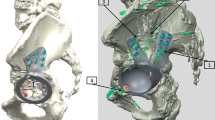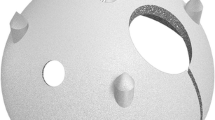Abstract
The long-term success of primary total hip arthroplasty in elderly patients has been well documented. In addition, the use of uncemented acetabular components in younger patients has been well established. However, as yet, there has not been widespread use of uncemented acetabular components in older patients. This study reviews a single surgeon series of 179 consecutive primary total hip replacements using an uncemented acetabular component. Patients were followed up clinically, radiologically and by means of a postal questionnaire. Patients were divided into under-70 years (n = 80) and 70 years and older (n = 99). There were 88 males and 91 females who were followed up to a mean of 24.1 months. There were no significant differences between the groups with respect to the need for additional screw fixation, post-operative complications or implant loosening. Functionally, no differences were recorded in terms of pain, limp, mobility or ability to put on shoes and socks post-operatively. There was no significant difference between the two groups in the levels of satisfaction reported. These results justify the use of uncemented acetabular components in older patients.
Résumé
Les succès à long terme de l’arthroplastie totale de hanche de première intention chez les personnes âgées a été bien analysée et documentée. De plus l’utilisation de cupules acétabulaires non cimentées chez des sujets plus jeunes est bien établie. Cependant à ce jour l’utilisation large de cupules non cimentées chez les patients âgés n’a pas été prônée. Cette étude porte sur 179 poses consécutives de prothèses de hanche par le même chirurgien avec utilisation d’une cupule acétabulaire non cimentée. Les patients ont été suivis cliniquement, radiologiquement et grâce à un questionnaire envoyé par la poste. Les patients ont été regroupés en deux groupes, âge inférieur à 70 ans (n = 80) et âge de 70 ans et au-delà (n = 99). Il y avait 88 hommes et 91 femmes qui ont été suivis en moyenne 24.1 mois. Il n’ a pas été noté de différence significative entre les deux groupes concernant la nécessité de vis additionnelles, les complications post-opératoires ou le descellement des implants. Au point de vue fonctionnel aucune différence n’a pas non plus été notée concernant les douleurs, la boiterie, la mobilité, la possibilité de se chausser et de mettre ses bas ou chaussettes. Enfin aucune différence n’est apparue entre les deux groupes quant au degré de satisfaction. Ces résultats justifient l’utilisation de cupules acétabulaires non cimentées chez les personnes âgées.


Similar content being viewed by others
References
Adler E, Stuchin SA, Kummer FJ (1992) Stability of press-fit acetabular cups. J Arthroplasty 7(3):295–301
Berry DJ, Harmsen WS, Cabanela ME, Morrey BF (2002) Twenty-five year survivorship of two thousand consecutive primary Charnley total hip replacements: factors affecting survivorship of acetabular and femoral components. J Bone Joint Surg 84A:171–177
Boettcher WG (1992) Total hip arthroplasties in the elderly. Morbidity, mortality, and cost effectiveness. Clin Orthop 274:30–34
Brander VA, Malhotra S, Jet J, Heinemann AW, Stulberg SD (1997) Outcome of hip and knee arthroplasty in persons aged 80 years and older. Clin Orthop 345:67–78
Christie J, Burnett R, Potts HR, Pell AC (1994) Echocardiography of transatrial embolism during cemented and uncemented hemiarthroplasty of the hip. J Bone Joint Surg 76B:409–412
Curtis MJ, Jinnah RH, Wilson VD, Hungerford DS (1992) The initial stability of uncemented acetabular components. J Bone Joint Surg 74B:372–376
Della Valle AG, Zoppi A, Peterson MG, Salvati EA (2004) Clinical and radiographic results associated with a modern, cementless modular cup design in total hip arthroplasty. J Bone Joint Surg 86A:1998–2003
Dorr LD, Wan Z, Gruen T (1997) Functional results in total hip replacement in patients 65 years and older. Clin Orthop 336:143–151
Dunkley AB, Eldridge JD, Lee MB, Smith EJ, Learmonth ID (2000) Cementless acetabular replacement in the young. A 5- to 10-year prospective study. Clin Orthop 376:149–155
Ekelund A, Rydell N, Nilsson OS (1992) Total hip arthroplasty in patients 80 years of age and older. Clin Orthop 281:101–106
Hagio K, Sugano N, Takashina M, Nishii T, Yoshikawa H, Ochi T (2003) Embolic events during total hip arthroplasty: an echocardiographic study. J Arthroplasty 18(2):186–192
Healy WL (1995) Economic considerations in total hip arthroplasty and implant standardization. Clin Orthop 311:102–108
Healy WL (2002) Hip implant selection for total hip arthroplasty in elderly patients. Clin Orthop 405:54–64
Keisu KS, Orozco F, Sharkey PF, Hozack WJ, Rothman RH (2001) Primary cementless total hip arthroplasty in octogenarians: two to eleven-year follow up. J Bone Joint Surg 83A:359–363
Levy RN, Levy CM, Snyder J, Digiovanni J (1995) Outcome and long-term results following total hip replacement in elderly patients. Clin Orthop 316:25–30
Massin P, Schmidt L, Engh CA (1989) Evaluation of cementless acetabular component migration. An experimental study. J Arthroplasty 4(3):245–251
Orsini EC, Byrick RJ, Mullen JB, Kay JC, Waddell JP (1987) Cardiopulmonary function and pulmonary microemboli during arthroplasty using cemented or non-cemented components. The role of intramedullary pressure. J Bone Joint Surg 69A:822–832
Pettine KA, Aamild BC, Cabanela ME (1991) Elective total hip arthroplasty in patients older than 80 years of age. Clin Orthop 266:127–132
Rorabeck CH, Bourne RB, Mulliken BD, Nayak N (1997) Acetabular osteolysis with cementless cups: a 5 to 7 year follow-up. Acta Orthop Belg 63(Suppl 1):83–92
Sharkey PF, Hozack WJ, Callaghan JJ et al (1999) Acetabular fracture associated with cementless acetabular component insertion: a report of 13 cases. J Arthroplasty 18(2):186–192
Spicer DD, Schaper LA, Pomeroy DL, et al (2001) Cementless cup fixation in total hip arthroplasty after 5–8 years. Int Orthop 25(5):286–289
Torga Spak R, Stuchin SA (2005) Cementless porous-coated sockets without holes implanted with pure press-fit technique. J Arthroplasty 20(1):4–10
Wixson RL, Stulberg SD, Mehlhoff M (1991) Total hip replacement with cemented, uncemented, and hybrid prostheses. A comparison of clinical and radiographic results at two to four years. J Bone Joint Surg 73A:257–270
Author information
Authors and Affiliations
Corresponding author
Rights and permissions
About this article
Cite this article
Wahab, A., Quinlan, J.F., Sherif, S. et al. Are cementless acetabular components contra-indicated in the elderly?. Eur J Orthop Surg Traumatol 17, 263–266 (2007). https://doi.org/10.1007/s00590-006-0170-4
Received:
Accepted:
Published:
Issue Date:
DOI: https://doi.org/10.1007/s00590-006-0170-4




